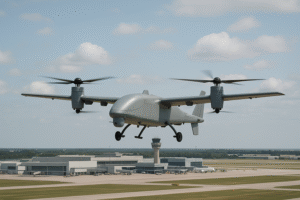Over the past weeks, a wave of drone intrusions—reportedly large, capable systems (on the order of a small vehicle)—has rattled parts of Europe. Airports, military sites, and national airspaces in Denmark, Germany, and Lithuania have repeatedly gone into high alert, forcing runway closures, flight suspensions, and political headlines.
The pattern is alarming not simply because of the volume of sightings, but because of the implied capability: these are not backyard toys. Authorities and analysts treating them as military-grade or semi-military assets are now scrambling to understand who is behind them, how they operate, and why none have been photographed convincingly yet.
Affected Airports & Airspaces
Germany — Munich and Beyond
-
Munich Airport has been shut down multiple times in under 24 hours due to drone sightings near both the north and south runways. The drones depart before identification. (AP News)
-
A press release from Munich Airport notes that flight operations were suspended at 22:35 local time when drones were reported inside the airport grounds; 17 flights were cancelled, 15 diverted. (Munich Airport Press)
-
Reuters reported that some drones spotted near Munich were described as “used militarily.” Further, reported sightings also occurred over a police airborne unit base in Gifhorn and near an ammunition depot in northern Germany — raising suspicions about coordinated probing of both civil and military infrastructure. (Reuters)
Denmark — Multiple Airports
-
Copenhagen Airport (Kastrup) was closed for about four hours after sightings of multiple large drones maneuvering near approach paths and runway perimeters. Danish police explicitly called the actor “capable.”
-
Several other airports in Denmark (Billund, Aalborg, Skrydstrup, and others) were also temporarily shut or placed under restrictions after similar large drone sightings. The incidents were described by officials as “systematic” and raising the possibility of hybrid warfare tactics. (See: 2025 Danish drone incidents page)
-
Denmark’s government banned all civilian drone operations nationwide during the period as a precaution, and increased NATO region support in the Baltic Sea.
Lithuania — Vilnius & Strategic Sites
-
Vilnius Airport experienced two closures in one night following reports of large drones in its vicinity.
-
Earlier in September, the Lithuanian president’s flight was delayed over drone concerns.
-
In prior months, Lithuania has seen incursions of the Gerbera drone (a known military-capable UAV) across its border with Belarus. One such Gerbera drone, loaded with ~2 kg of explosives, was found crashed in central Lithuania about 100 km from the border. (Wikipedia: Gerbera drone)
What Makes These “Car-Sized” Incursions Different
-
The trajectories, lighting patterns, and flight behaviors imply professional piloting and avionics, not simple hobbyist control.
-
The incursions often occur at night and near airport approach/exit corridors, maximizing disruption while minimizing detection window.
-
Authorities are treating many of these drones not as casual probes but as hybrid warfare or intelligence pressure tools.
Why No One Has Photographed One Yet
-
Rapid entry and exit: The drones appear for minutes, hover or transit, then vanish before response teams can converge. The slack window is slim.
-
Restricted zones: Airports tightly control airside visibility. Getting a camera in range without being pushed back is near impossible.
-
Low profile & stealth design: If these are military/advanced systems, they may be engineered for low radar signature, low acoustic profile, and limited lighting—making clear visual capture hard.
-
Night operations: All major incidents are happening in darkness. Infrared/thermal or low-light optics are harder to deploy casually.
-
No confirmed recovery: No one has recovered a drone carcass in these airport incidents (unlike earlier border-crashed drones). Without wreckage, you’ll never see structure, serials, or designation.
Until one malfunctions, is forced down, or is intercepted in daylight, we may not get a credible image.
Official Responses & Legal Limits
-
Germany is pushing to give police shoot-down powers and establishing a joint drone defence centre. Currently, jurisdictional and legal restraints slow kinetic countermeasures. (Reuters)
-
Munich’s official statement says that tactical details (e.g. sensor systems deployed) are withheld for operational reasons. (Munich Airport Press)
-
In Denmark, officials have briefed NATO partners, treated the incursions as a serious attack on critical infrastructure, and temporarily banned all civil drone flights to reduce noise and conflict.
-
Lithuania has empowered the military to shoot down drones violating national airspace following persistent incursions.
The New Jersey Precedent (Late 2024)
A comparable drone wave struck New Jersey in late 2024. Hundreds of sightings, mostly at night, over towns and airspace, raised fears of foreign or domestic threat. Investigations by the FBI and White House concluded many incursions had benign explanations, with no evidence of a coordinated hostile campaign. Some drones were deemed FAA-authorized, or tied to civilian operators. Unlike Europe now, none of those US incidents produced credible claims of large, military-style drone systems.
The Theories That Remain Plausible
-
State-linked hybrid probing: The leading hypothesis is that a foreign actor is probing air defenses and airport response policies without open escalation.
-
Deliberate disruption / deterrence: The goal might not be to damage, but to impose cost, sow uncertainty, and flaunt sovereignty vulnerabilities.
-
Mixed tactics + decoys: Even with serious incursions, low-level “noise” could mask them or confuse defenses.
-
Domestic proxy operations: A controlled third party or contractor adopting state methods—but, at this scale, that seems less likely.
What Will Change the Picture
What shifts this from mystery to certainty is a recoverable platform, radar/infrared sensor logs, or a camera-quality image. Once a carcass is recovered—or a drone is forced down over open terrain—the origin, design, and intent may become clear. Until then, Europe is in a delicate dance: highly alert, under legal constraints, and scrambling to build the defenses these intrusions demand.



